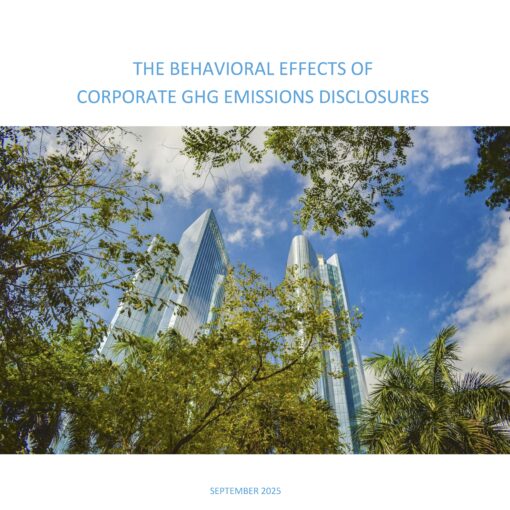 Climate alliances have become a common target of antitrust campaigns over the last several years, particularly given the complex market dynamics for these alliances to navigate, with effective industry-wide transformation often necessitating some degree of coordination among competitors. In previous blog posts, we have addressed state legislatures’ efforts to undermine reasonable climate-mitigation investment initiatives—often by claiming that such initiatives engage in unlawful boycotts or discriminatory debanking conspiracies against emissions-intensive enterprises. Today’s post details overzealous federal enforcement against California’s Clean Truck Partnership. Another blog tomorrow will discuss executive-branch attacks on corporate climate alliances at the state level.
Climate alliances have become a common target of antitrust campaigns over the last several years, particularly given the complex market dynamics for these alliances to navigate, with effective industry-wide transformation often necessitating some degree of coordination among competitors. In previous blog posts, we have addressed state legislatures’ efforts to undermine reasonable climate-mitigation investment initiatives—often by claiming that such initiatives engage in unlawful boycotts or discriminatory debanking conspiracies against emissions-intensive enterprises. Today’s post details overzealous federal enforcement against California’s Clean Truck Partnership. Another blog tomorrow will discuss executive-branch attacks on corporate climate alliances at the state level.
Establishment and Disavowal of the Clean Truck Partnership
In August, the federal antitrust campaign against reasonable climate-minded cooperation achieved one of its most decisive wins to date. The Republican-dominated Federal Trade Commission effectively dismantled the Clean Truck Partnership (CTP)—one of the last readily available means for California to promote national reductions in auto emissions, through multilateral arrangements with major truck manufacturers. Yet there is reason to avoid an overly broad reading of the FTC’s regulatory mandate on these topics. Future efforts by states to secure voluntary commitments from firms on supply levels for carbon-intensive products may not be precluded—and voluntary commitments on emissions levels remain even farther from the FTC’s proper regulatory scope.
Groundwork for the CTP was laid between 2020 and 2023, when the California Air Resources Board (CARB) issued three sets of regulations intended to reduce greenhouse gas emissions from medium- and heavy-duty vehicles, imposing stringent emissions standards and requiring the eventual phase-out of new gas-powered trucks. The Biden administration’s EPA waived federal preemption of these regulations under the Clean Air Act.
In furtherance of these regulations, CARB also established the CTP with manufacturers comprising more than 90% of the U.S. market in heavy-duty trucks (including Daimler, Volvo, International Motors, Paccar, and their trade association). Under the CTP, manufacturers received additional time to comply with California’s regulations, while pledging that they would meet these new clean-truck standards “regardless of whether any other entity challenges California’s authority” to set emissions standards more stringent than the federal government’s. In other words, should a new administration come to power and assert federal preemption, as President Trump’s did after Congress’s disapproval of the EPA waiver in June of this year (under a questionable reading of the Congressional Review Act), CTP participants pledged to voluntarily abide by California’s clean-truck measures.
Spokespersons for the truck manufacturers noted in 2023 that the extended compliance timeline, and a uniform regulatory environment less subject to political whiplash, made CTP participation a net benefit for business operations. Yet on August 12, 2025, the FTC announced resolution of an antitrust investigation of the CTP. Truck manufacturers and their trade representatives acknowledged the partnership could not be enforced, agreed to act independently in selling trucks, and agreed “not to negotiate or enter into future agreements like the Clean Truck Partnership”—subject to seven years of annual compliance reports.
Antitrust Concerns Raised by the Multilateral Agreement
A statement issued by the FTC upon closing its CTP investigation (the FTC Statement) downplays California’s central role in the partnership. Instead, the FTC frames the CTP as a multilateral, quasi-contractual document “signed by all the significant competitors in a market,” who agreed to “reduce output under the guise of…ESG objectives.”
Under Section 1 of the Sherman Act, such an arrangement (if accurately described by the FTC) would raise legitimate concerns of anticompetitive collusion by market rivals. The FTC Statement asserts, for example, that the CTP “raises the specter” of one truck manufacturer attempting to “enforce the CTP’s output restrictions against…competitors” —particularly in a scenario where federal preemption deprived California of its authority to enforce the clean-truck standards. While governmental regulations restraining trade in pursuit of public-policy objectives typically receive antitrust immunity under the “state action” doctrine, private regulation imposed by a politically unaccountable corporate cartel has long been subject to antitrust enforcement.
Under Section 1 case law, collusive output reductions intended to raise market prices typically receive per se legal analysis, as agreements that inherently harm competition—meaning that harmful effects need not be proven in court. Along related lines, the FTC Statement argues that the mere possibility of one truck manufacturer enforcing the CTP against another constrains each participant manufacturers’ “incentive and ability to compete unilaterally and freely,” presumably meriting per se treatment.
The FTC Statement conspicuously sets aside the factual record following real-world repeal of EPA’s clean-truck waiver: instead of suing each other to reinforce the CTP’s purported output reduction, the four major truck manufacturers collectively sued California, seeking a court injunction barring CARB from pressuring them to abide by their CTP pledges (note that their joint lawsuit was not unlawful coordination, since under U.S. antitrust’s Noerr-Pennington doctrine, competing firms may jointly petition the government to address shared grievances). Nonetheless, the FTC Statement does sketch, at least in abstract terms, a potentially problematic multilateral agreement that included market competitors, that could (and did) see its state participant stripped of regulatory authority, and that could lead to anticompetitive harm.
Cracks in the FTC’S Antitrust Analysis
The FTC’s fair point that the “antitrust concerns are obvious” in this arrangement does not by itself confirm the Commission could have marshalled an effective legal case establishing that the CTP reduces competition through an unlawful output restriction.
To determine whether a purported restraint has anticompetitive effects, the courts must first define the market in which any effects occur. This is a highly technical process. In the case of the CTP, the market might be comprised of gasoline-powered trucks, or trucks powered by any energy source, or broader classes of commercial-transport vehicles and platforms. The broader the definition, the more room truck manufacturers would have had to demonstrate that they were meeting consumer demand for commercial-transport capacity, while updating their fleets for today’s climate-minded markets and regulatory environment. Supplying new capacity in this way would negate claims of a meaningful constraint on output.
The FTC’s framing of an unlawful output reduction would have faced further definitional snags. The FTC Statement brusquely notes, for example, that “our antitrust laws take the dimmest possible view of agreements among competitors to restrict output or otherwise…cease competing.” The FTC cites for this proposition the influential Supreme Court decision Leegin Creative Leather Products v. PSKS (2007), which states: “A horizontal cartel among competing manufacturers…that decreases output or reduces competition in order to increase price is, and ought to be, per se unlawful.” Yet the FTC Statement offers no plausible argument that California’s recent truck regulations or the CTP agreement were designed “in order to increase price” for truck manufacturers’ benefit.
Absent a per se output reduction, the FTC would have had to contend with rule-of-reason analysis, first establishing the CTP’s harm to competition, and then overcoming the pro-competitive rationales defendants could offer for the agreement. One clear weak point for the FTC’s establishment of market harms stems from its speculative assertion that “collectively adopted emissions limits…in practice, would similarly limit production.” This formulation reflects a common but unpersuasive argument by climate-skeptic antitrust enforcers that misapplies output-reduction analysis to reductions in firms’ negative externalities (here, their carbon emissions), rather than in their supply of goods and services (here, commercial-transport capacity). After all, consumers don’t demand an opportunity to pollute by driving high-emitting trucks; they demand vehicles to move physical materials around.
In terms of procompetitive defenses, truck manufacturers could have argued that the CTP’s four-year compliance timeline (and the protracted 12-year timeline to phase out sales of new gas-powered trucks) would, on balance, stimulate competition in the relevant market. Industry-specific procompetitive rationales require a detailed analysis which we do not attempt here. But it is worth noting that start-up EV brands, freed from the need for capital-intensive investments in combustion-engine powertrains, are proliferating at a pace the auto sector has not experienced in a century. Cost disparities between gas-powered and electric light-duty vehicles have dropped significantly in recent years, suggesting possibilities for equivalent pricing dynamics with heavy-duty vehicles as battery technologies continue to advance (setting aside whether sticker price provides the most useful point of pricing comparison, given EVs’ substantially lower long-term operational costs). In short, market dynamics may naturally drive supply to shrink for gasoline trucks, should they become increasingly obsolete product lines with ample product substitutes.
Antitrust Enforcement Overreach
As noted above, the FTC Statement highlights distinctive features of the CTP, characterizing it as “decidedly different than a traditional regulation imposed by a politically accountable state regulator.” The FTC Statement celebrates post-CTP binding commitments made by participant truck manufacturers not to “replicate the CTP’s most problematic provisions in the future.” Taken together, these points suggest the investigation’s outcome should have a narrow legal impact on states’ regulatory capacities. California may face constraints in shaping national auto policy, at least during spans of federal hostility to this state’s distinct status under the Clean Air Act. But “traditional regulation” should be able to continue unimpeded.
However, remedies obtained by the FTC through this investigation appear to extend beyond the agency’s scope of enforceable authority (mirroring, in fact, the problematic regulatory overreach that the FTC ascribes to CARB). The investigated CTP parties have pledged not only to abstain from further multilateral agreements on supply or emission levels, but also from certain bilateral agreements with states.
In the FTC’s summary, each targeted truck manufacturer has now pledged, as a first commitment, “not to enter an agreement with any U.S. state regulator or U.S. state government that fixes output or emissions levels and [italics added] permits cross-enforcement by competitors.” Accordingly, each of these manufacturers might still be able to enter a bilateral agreement with California or other states on related topics. In such cases, there would be much less concern about collusion between market competitors.
Yet the truck manufacturers have also made other pledges. As set out in Daimler’s Letter of Commitment to the FTC, they have also pledged not to “enter or attempt to enter into any agreement with a U.S. state regulator…relating to restrictions on supply or fixing emission levels, by which [Daimler] commits to being bound even if the state actor…lacks authority to directly impose or enforce the applicable restrictions.”
But where does the FTC derive the authority to police an agreement on emissions levels between one state and one truck manufacturer? While a limit on supply is familiar antitrust terrain, limits on “emissions levels” are well outside it.
The FTC has suggested that, in signing onto the CTP, participating truck manufacturers had capitulated before California’s bullying “attempts to coopt private businesses to enforce preempted regulations in large swaths of the nation.” The FTC should not now bully those same manufacturers into reinforcing its overzealous and under-scrutinized attacks on lawful state measures to reduce emissions.






